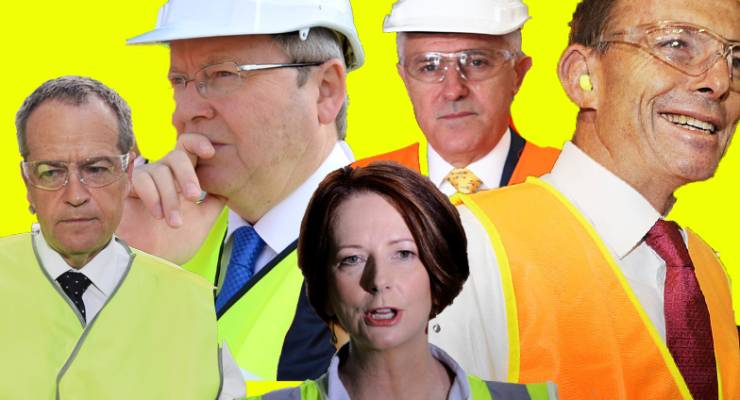
Noticed a surge in pictures of politicians in fluoro vests in recent days? Yes, it’s the now-standard election campaign game of dress-ups.
Malcolm Turnbull and Bill Shorten are suddenly wearing high-vis clothing, helmets, eye protection and protective footwear as they tour manufacturing workplaces talking about jobs, tailed by media packs who have all been strictly told “no open-toed shoes”.
This obsession with the high-vis vest and other safety garb is relatively recent. John Howard rarely donned such gear; Kevin Rudd did it a bit in 2007, and much more so in 2013. Tony Abbott, though, was the king of workplace couture, readily donning the fluoro to drive a truck, tour a workplace, fight a fire, gut a fish, pretty much anything, really. On the campaign trail in 2010, Julia Gillard tried gamely to match him, striking back with her own high-vis garb and eye protectors.
Now, Malcolm Turnbull and Bill Shorten are touting their wares in orange and lime on shop floors across the land.
Such gear isn’t natural for most of these people. John Howard, a professional politician; Kevin Rudd, a former diplomat; Julia Gillard, a labour lawyer, Tony Abbott, a Riverview-and-Sydney-University-educated Rhodes scholar and seminarian, Malcolm Turnbull, a lawyer and investment banker. Only Shorten, who spent plenty of time in manufacturing and construction workplaces as a union official, would have ever worn such clothing for a legitimate purpose in his past.
Why the love for such gear? First, it’s because politicians like to visit manufacturing workplaces, ahead of service industry workplaces or offices, because they look better on television. Other workplaces that also look good on TV, like hospitals or schools, can be harder to get into and tend to require specific announcements relating to health and education.
Wandering around a manufacturing workplace (much more so than a construction site, which also requires safety gear) looks good because it appeals to voters’ innate belief that factories are places of real economic activity, in contrast to what most of us do, which is work in some form of service sector. The electorate retains a comforting image of work as involving making things, however out-of-date and strongly gendered such a view is, and politicians are trying to leech off the sense of manufacturing as somehow being the real economy.
The other, more substantial, reason is that political leaders know their own profession is poorly regarded by the electorate, so whether they’re visiting a manufacturing workplace or not, they like to dress up as a worker perceived to have more credibility and authenticity. That is, in order to stymie voter perceptions that politicians pretend to be something that they’re not, they pretend to be something that they’re not.
The thing is, politics is actually an honourable profession, whether voters think that or not. There’s nothing to be despised in putting your hand up to participate in government. And most politicians — especially House of Reps MPs — work damn hard, and senior politicians carry a massive workload that most people never see. But because politicians are so despised, because modern political communication is about robotically uttering talking points rather than genuinely connecting with voters, they try to leech authenticity from more respected occupations by appearing like them.
The irony gets richer when you note (as my colleague Helen Razer and I did in A Short History of Stupid) that donning the costume of a manufacturing worker is becoming more common as manufacturing, due to the neoliberal economic policies of both major parties, steadily shrinks to economic irrelevance. However beneficial such policies are for the nation as a whole, there’s something of Marie Antoinette’s Little Hamlet about all this, elites pretending to be lower class while the lower class suffers as a result of elite policies. Indeed, the Little Hamlet at Petit Trianon is even more apt as Australia’s manufacturing sector takes on an ever more artificial air, propped up by government subsidies and handouts in an ill-considered but electorally popular effort to stem the steady erosion of the sector as a result of global competition.
Meanwhile, the sectors that Australia thrives in, that employ so many more people, in offices, business parks, shops, classrooms and hospitals around the country, lay unused as backdrops for campaign stagecraft, the ordinary clothing that most of us don to go to work ignored by politicians who like playing dress-ups.








When a politician dons high-viz gear they may as well be wearing a clown suit.
It’s even worse when visiting a food manufacturing business, forced to wear a type of gown & hairnet/bonnet they appear ridiculous. And they fool no-one.
“lie unused”
Excellent article, Bernard. Thankyou.
“manufacturing, due to the neoliberal economic policies of both major parties, steadily shrinks to economic irrelevance”
Neoliberal economic policies may, at most, have spurred along such shrinkage, but at the end of the day if Australia is not able to compete with other nations in the manufacturing sector (high wages, small population etc. etc.) then it’s going to shrink anyway.
The fact that clearly there would be many votes to be won in offering support to help keep our manufacturing sector afloat but neither party do anyway is pretty telling – the sums have been done and it’s just not a particularly effective way for governments to boost the economy. And it’s fair to point out that countries like Germany don’t have thriving manufacturing sectors because of direct government support.
To whom does ‘Wandering around a manufacturing workplace… looks good’?
They look like what they are, poseurs trying to pretend to people whom they despise that they are ‘just like them uns’.
Even more idiotic is when they point at things for the still photographers.